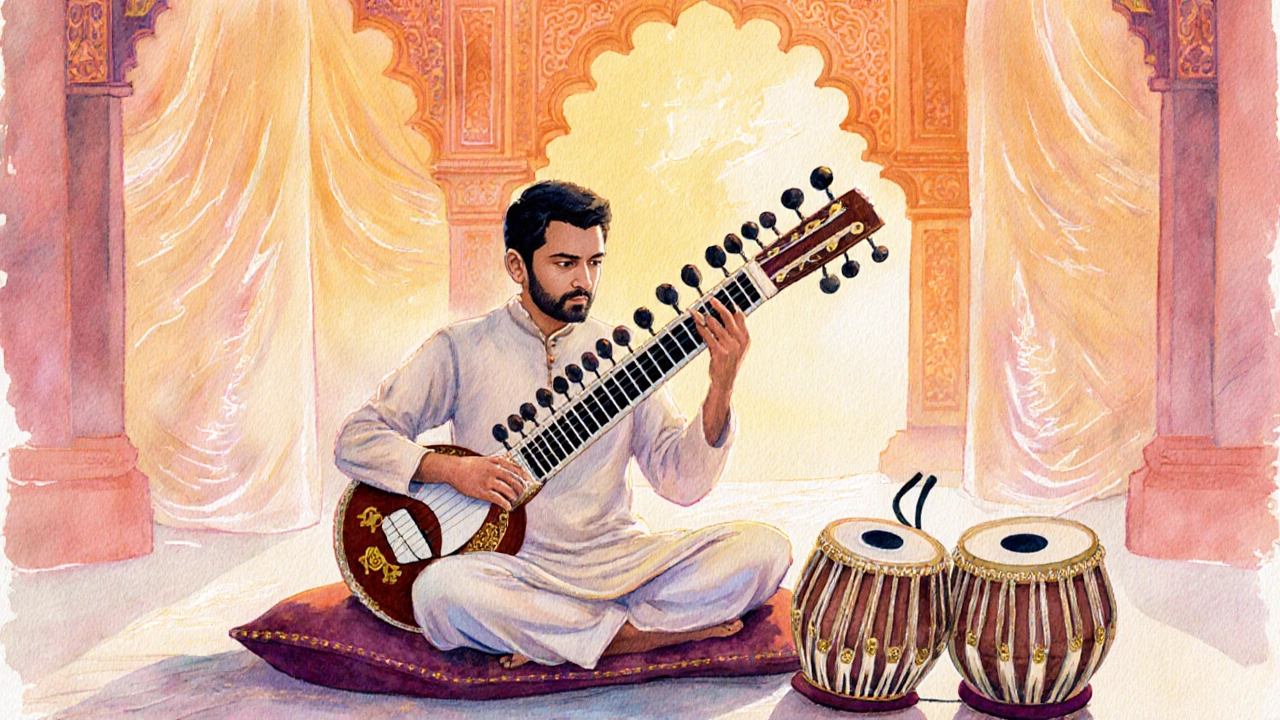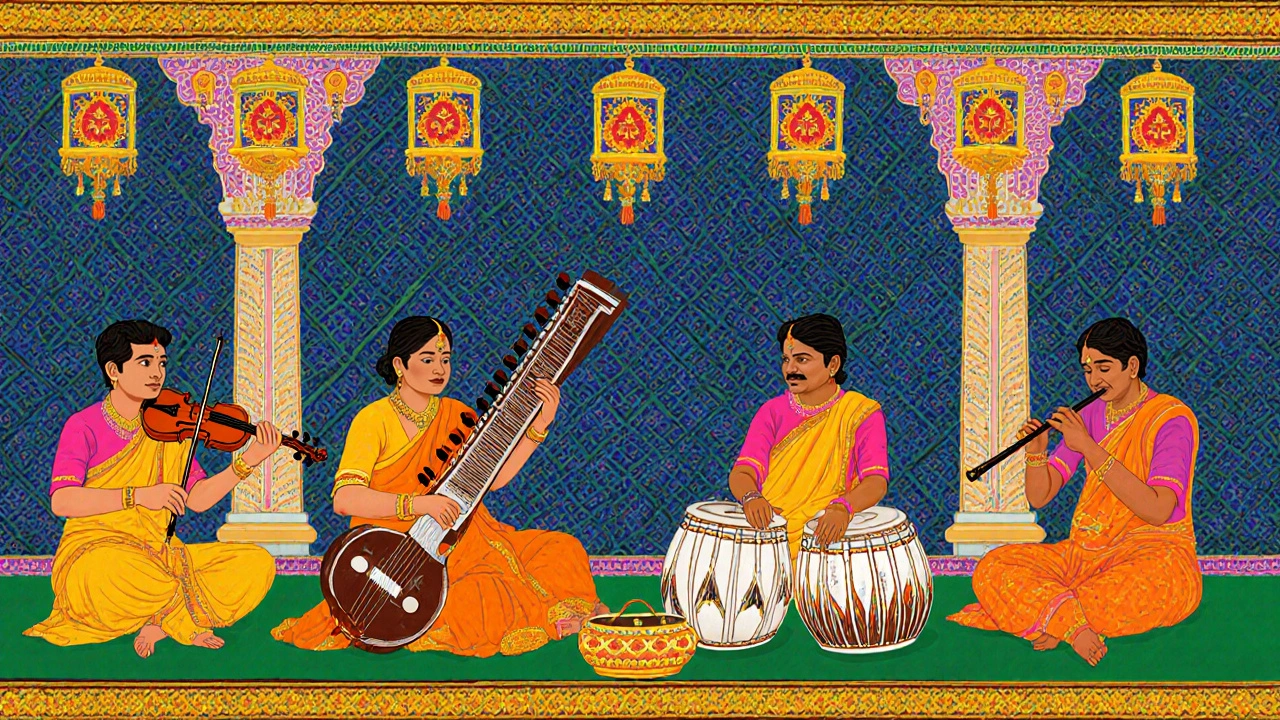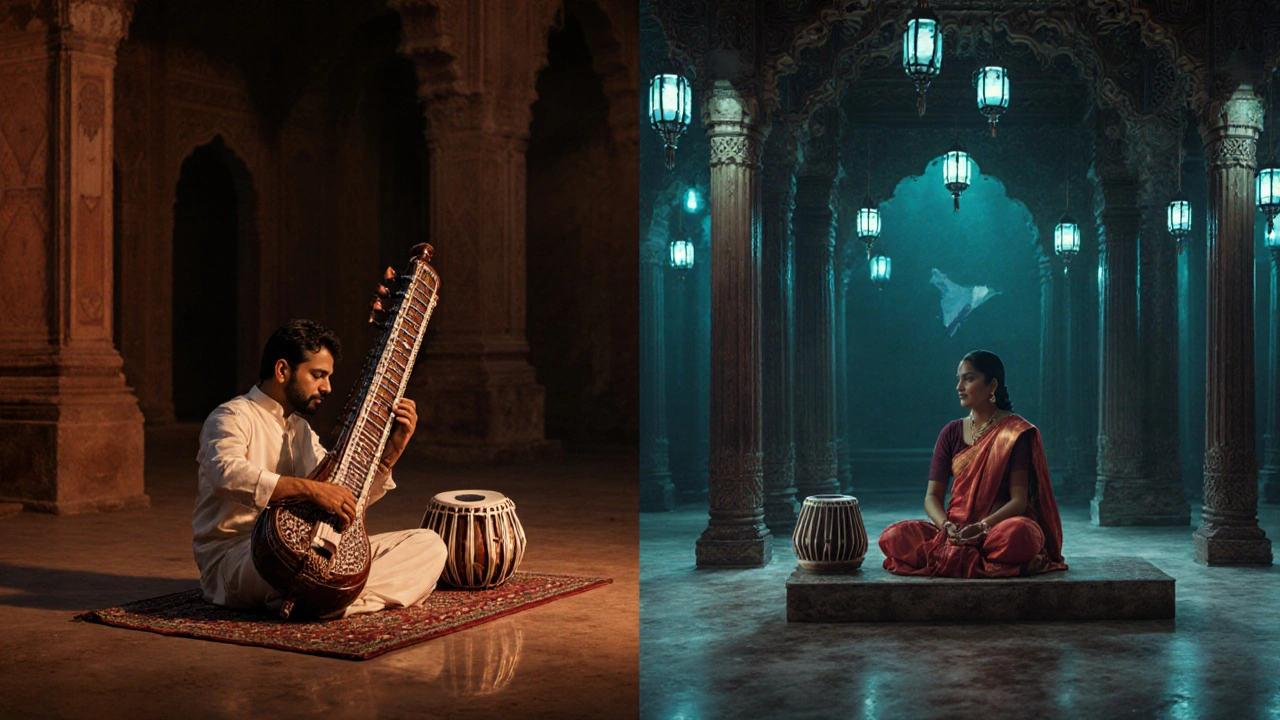Hindustani vs Carnatic Music Explorer
Explore the key differences between Hindustani and Carnatic music traditions. Click on each card to see detailed features.
Hindustani Music
North Indian classical tradition influenced by Persian and Mughal aesthetics.
Carnatic Music
South Indian classical tradition rooted in temple traditions and devotional themes.
Key Features Comparison
| Feature | Hindustani | Carnatic |
|---|---|---|
| Performance Style | Improvisation-driven, slow unfolding | Composition-focused, rhythmic complexity |
| Primary Instruments | Sitar, Tabla, Sarod, Bansuri | Veena, Mridangam, Violin, Flute |
| Rhythm System | Taal (steady beats) | Tala (complex rhythmic cycles) |
| Learning Method | Guru-shishya parampara (oral tradition) | Formalized syllabus, institutional teaching |
Quick Takeaways
- Indian classical music splits into two main systems: Hindustani (North India) and Carnatic (South India).
- Both share the concepts of raga (melodic framework) and tala (rhythmic cycle), but they apply them differently.
- Hindustani leans on improvisation and a slow, unfolding style; Carnatic focuses on composition and rhythmic intricacy.
- Key instruments differ: sitar and tabla dominate Hindustani, while veena and mridangam are central to Carnatic.
- Understanding the two traditions helps you choose concerts, teachers, and recordings that match your taste.
When you hear the phrase “Indian classical music,” most people picture a sitar solo or a complex vocal piece, but the reality is far richer. The music of the sub‑continent is organized into two distinct traditions -Hindustani in the north and Carnatic in the south. This article unpacks what each system is, how they grew, and what makes them tick, so you can finally answer the age‑old question: “What are the two main types of Indian classical music?”
What is Indian Classical Music?
Indian classical music is a centuries‑old art form that blends melody, rhythm, and spirituality. It evolved from Vedic chants, courtly patronage, and regional folk traditions, eventually crystallizing into two formal schools that still dominate performance today. While the two schools share a philosophical backbone - the belief that music can elevate the soul - they diverge in history, structure, and performance practice.
The Two Main Traditions
Broadly speaking, the north of the sub‑continent nurtured Hindustani music, whereas the south cultivated Carnatic music. Both trace roots to the ancient Natya Shastra, but each took its own path after the 12thcentury, when Persian influences entered the north and the southern kingdoms retained a stronger link to earlier Hindu temple traditions.
Hindustani Music Overview
Hindustani music originated in North India and is heavily shaped by Persian‑Mughal aesthetics. Its hallmark is the slow, meditative unfolding of a raga, often stretching an hour or more. Performances typically begin with an alap - a word‑less exploration of the raga’s mood - followed by a rhythmic section called jor and finally a full band accompaniment.
Key vocal forms include Khayal, Dhrupad, and Thumri. Instrumental stalwarts are the sitar, sarod, and bansuri (bamboo flute). The rhythm section centers on the tabla, a pair of hand‑drummed kettles capable of producing nuanced bols (syllables).

Carnatic Music Overview
Carnatic music developed in South India and stays closely tied to Hindu devotional themes. Its structure is composition‑driven, with each piece clearly notated. A typical concert flows from a varnam (technical warm‑up) to a series of kritis (devotional compositions) and ends with a rapid improvisational finale called kalpanaswaram.
Principal vocal styles include the classic Carnatic kriti, while instrumentalists favor the veena, violin (adapted to Indian tuning), and mridangam - a double‑headed drum that provides intricate rhythmic patterns.
Core Elements: Raga and Tala
Raga is a melodic framework that defines a set of notes, their ascending and descending order, and characteristic phrases that evoke a specific mood or time of day. Both Hindustani and Carnatic use ragas, but the naming conventions and ornamentations differ. For example, Hindustani’s “Yaman” corresponds roughly to Carnatic’s “Kalyani,” yet each school applies distinct gamakas (ornaments).
Tala is the rhythmic cycle that underpins a performance, ranging from 6‑beat cycles (e.g., Teen Taal in Hindustani) to complex 8‑beat cycles (Adi Tala in Carnatic). In Hindustani, tala is often kept steady by the tabla; in Carnatic, the mridangam and additional percussionists create layered syncopations.
Signature Instruments
- Sitar a long‑necked lute with sympathetic strings, iconic in Hindustani performances.
- Tabla a pair of hand‑drummed kettles that articulate Hindustani talas with crisp bols.
- Veena a plucked harp‑like instrument central to Carnatic music, offering deep, resonant tones.
- Mridangam a double‑headed drum that drives Carnatic rhythmic cycles with intricate finger work.
Side‑by‑Side Comparison
| Aspect | Hindustani (North) | Carnatic (South) |
|---|---|---|
| Historical Influence | Persian‑Mughal courts, Vaishnavite bhakti | Temple traditions, Tamil and Telugu bhakti |
| Primary Forms | Khayal, Dhrupad, Thumri, instrumental ragas | Kritis, Varnams, Tillanas, Jugalbandi |
| Improvisation Style | Slow alaps → rhythmic improvisation (taans) | Melodic improvisation (kalpanaswaram) after each kriti |
| Typical Instruments | Sitar, Sarod, Bansuri, Tabla | Veena, Violin, Flute, Mridangam |
| Common Talas | Teen Taal (16beats), Rupak (7beats) | Adi Taal (8beats), Rupakam (6beats) |
| Learning Path | Guru‑shishya parampara; emphasis on oral transmission | Formalized syllabus; many institutions teach Carnatic |

Where to Experience Each Tradition
If you’re planning a trip or looking for local events, here’s a quick guide:
- Hindustani: Look for performances during the Delhi Music Festival, the Sarod concerts at the Aga Khan Museum (Toronto), or weekly classical evenings at cultural centers in cities like Sydney and London.
- Carnatic: Check out the Margazhi (December) festival in Chennai, Carnatic concerts at the Sydney Opera House’s “Music of India” series, or temple music sessions in Bangalore.
- Online platforms such as Saavn, Spotify, and the ITC Sangeet Research Academy archive provide high‑quality recordings of both styles.
When you sit down for a show, notice how Hindustani stretches the raga over a long, meditative arc, while Carnatic delivers a compact, composition‑rich journey. Both aim for the same spiritual peak - a feeling of timelessness.
Common Pitfalls for New Listeners
- Assuming a single raga equals a single song. In Hindustani, a raga can occupy an entire recital; in Carnatic, the same raga appears in multiple kritis with varied tempos.
- Mixing terminology. Words like “taal” (Hindustani) and “tala” (Carnatic) sound similar but refer to different notation systems.
- Expecting the same instruments. A sitar solo in Delhi will sound dramatically different from a veena piece in Chennai.
Stay aware of these nuances, and you’ll enjoy each performance on its own terms.
Frequently Asked Questions
What is the main difference between Hindustani and Carnatic music?
Hindustani music emphasizes improvisation and a slow, unfolding raga structure, while Carnatic music is more composition‑driven with tightly notated kritis and intricate rhythmic patterns.
Which instruments are unique to each tradition?
The sitar and tabla belong primarily to Hindustani, whereas the veena and mridangam are hallmarks of Carnatic music.
Can I learn both styles as a beginner?
Yes, but many teachers recommend focusing on one tradition first because the techniques, repertoire, and notation systems differ significantly.
Where can I find live performances outside India?
Major cultural festivals in cities like London, New York, Sydney, and Toronto regularly host both Hindustani and Carnatic concerts. Check local Indian cultural centers for monthly recital series.
What are some famous composers I should listen to?
In Hindustani, explore works by Tansen, Alauddin Khan, and Ravi Shankar. In Carnatic, listen to Tyagaraja, Muthuswami Dikshitar, and the modern maestro L.Subramaniam.
Next Steps for Curious Listeners
1. Pick a short streaming playlist that alternates a Hindustani raga and a Carnatic kriti. Notice the contrast in tempo and ornamentation.
2. Attend a local concert or a virtual live stream to feel the energy of live tabla or mridangam.
3. If you want to learn an instrument, start with a beginner-friendly sitar or veena tutorial and join a community forum for feedback.
4. Keep a simple notebook: write down the raga name, its time of day, and the emotional feeling it evoked. Over time, you’ll develop a personal map of Indian classical music.
